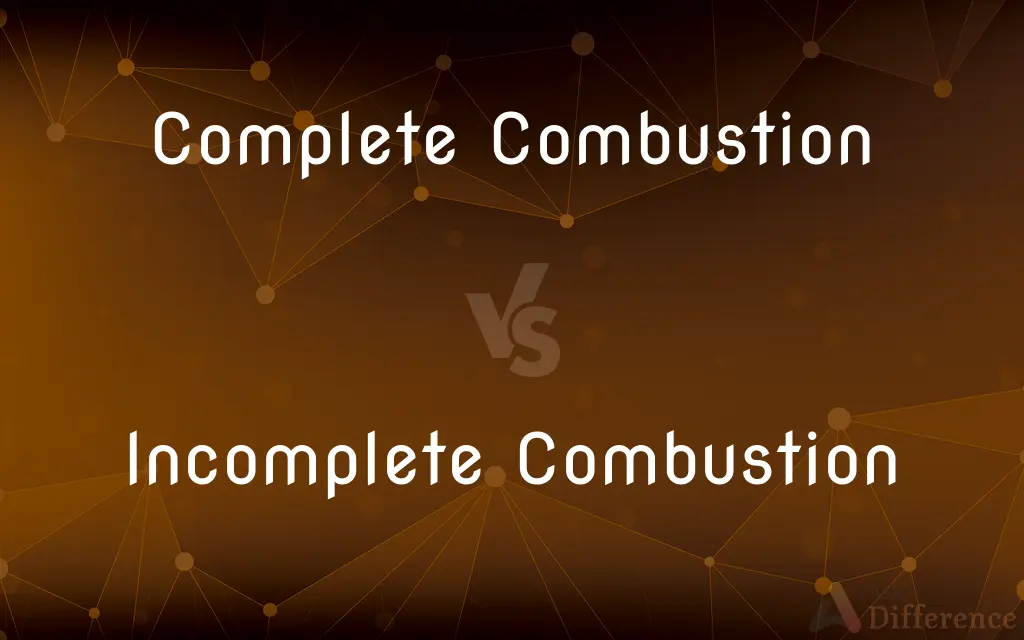Complete Combustion vs. Incomplete Combustion — What's the Difference?
By Tayyaba Rehman — Published on October 16, 2023
Complete Combustion occurs when a substance burns entirely, producing only carbon dioxide and water, while Incomplete Combustion results in additional byproducts like carbon monoxide.

Difference Between Complete Combustion and Incomplete Combustion
Table of Contents
ADVERTISEMENT
Key Differences
Complete Combustion and Incomplete Combustion are chemical reactions that involve the burning of hydrocarbons. Complete Combustion is an ideal process where a hydrocarbon burns completely with a sufficient amount of oxygen, producing only carbon dioxide and water. In contrast, Incomplete Combustion happens when there's not enough oxygen, leading to other byproducts like carbon monoxide, carbon, or soot.
While both types involve burning, the efficiency and results of these reactions differ greatly. Complete Combustion is preferred in many applications because it extracts the maximum energy from the fuel and has cleaner byproducts. Incomplete Combustion, on the other hand, is less efficient, producing harmful pollutants that can be dangerous to health and the environment.
A significant implication of Incomplete Combustion is the production of carbon monoxide, a colorless and odorless gas. This gas can be lethal when inhaled, making it a major concern in poorly ventilated areas. Complete Combustion, conversely, does not produce such toxic gases, rendering it safer when all conditions are met.
It's essential to manage combustion processes to achieve Complete Combustion whenever possible. This is because, besides the health risks, Incomplete Combustion also affects fuel economy in engines and can lead to performance issues. Both types, however, play roles in various real-world scenarios, with Complete Combustion being the ideal.
Comparison Chart
Primary Products
Carbon dioxide and water
Carbon dioxide, water, carbon monoxide, carbon (soot), and other byproducts
ADVERTISEMENT
Oxygen Availability
Sufficient oxygen
Limited or insufficient oxygen
Efficiency
High efficiency (all fuel is burned)
Lower efficiency (some fuel remains unburned)
Environmental Impact
Minimal pollutants
Produces pollutants harmful to health and the environment
Potential Risks
Generally safe
Risk of carbon monoxide poisoning and other hazards
Compare with Definitions
Complete Combustion
Combustion with no harmful byproducts.
The lab aimed for complete combustion to minimize pollutants.
Incomplete Combustion
Combustion that doesn't burn a substance entirely.
The smoky flame indicated incomplete combustion.
Complete Combustion
Burning that results in only carbon dioxide and water.
To achieve complete combustion, the engine was finely tuned.
Incomplete Combustion
A process producing carbon monoxide, soot, or other byproducts.
The car's exhaust showed signs of incomplete combustion.
Complete Combustion
The ideal reaction of hydrocarbons with oxygen.
Complete combustion ensures maximum energy extraction from the fuel.
Incomplete Combustion
Result of limited oxygen availability during burning.
The candle, trapped in a jar, underwent incomplete combustion.
Complete Combustion
A process needing sufficient oxygen for full burn.
The open field provided an environment for complete combustion of the bonfire.
Incomplete Combustion
Burning leading to less-than-optimal energy release.
The furnace's incomplete combustion reduced its heating efficiency.
Complete Combustion
A combustion process where a substance burns fully.
The fireplace achieved complete combustion, leaving no smoke or residue.
Incomplete Combustion
Combustion causing potential environmental and health risks.
Incomplete combustion in the stove released harmful fumes into the home.
Common Curiosities
What dangerous gas can incomplete combustion produce?
Carbon monoxide.
Can incomplete combustion lead to soot formation?
Yes, soot is a common byproduct of incomplete combustion.
Which type of combustion is more environmentally friendly?
Complete combustion, as it produces fewer pollutants.
How can one ensure complete combustion in a fireplace?
By ensuring proper ventilation and using dry, well-seasoned wood.
Is soot only produced during incomplete combustion?
Primarily, yes. Soot is a typical byproduct of incomplete combustion.
Why is complete combustion preferable in engines?
It maximizes fuel efficiency and reduces pollutants.
Is complete combustion always achievable in real-world scenarios?
Not always, various factors can impede achieving complete combustion.
In which device is incomplete combustion a major concern?
In house furnaces, especially in poorly ventilated areas.
What are the main products of complete combustion?
Carbon dioxide and water.
Can incomplete combustion affect car performance?
Yes, it can reduce fuel economy and engine performance.
How can one reduce the risks of carbon monoxide from combustion?
Ensure proper ventilation and regular maintenance of combustion devices.
What determines whether combustion is complete or incomplete?
Oxygen availability is a key factor.
Why is carbon monoxide from incomplete combustion dangerous?
It's odorless, colorless, and can be lethal when inhaled.
Can the efficiency of a heating system be affected by combustion type?
Yes, incomplete combustion can reduce a system's heating efficiency.
Which combustion type is more energy efficient?
Complete combustion, as it extracts the maximum energy from fuel.
Share Your Discovery

Previous Comparison
Supermarket vs. Convenience Store
Next Comparison
Humble vs. KindnessAuthor Spotlight
Written by
Tayyaba RehmanTayyaba Rehman is a distinguished writer, currently serving as a primary contributor to askdifference.com. As a researcher in semantics and etymology, Tayyaba's passion for the complexity of languages and their distinctions has found a perfect home on the platform. Tayyaba delves into the intricacies of language, distinguishing between commonly confused words and phrases, thereby providing clarity for readers worldwide.















































